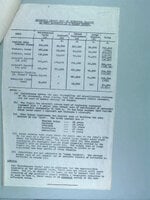According to Mason's The Secret Years:WBK, regarding the Wellington figures, is that range or radius? If radius, that would put it with B-17 and B-24 which i find suspicious, but of course i could be wrong. But even the very rangy G4M could only do 880 nautical miles max.
"Wellington Mark III
The first Hercules-engined Wellington, L4251, was
delivered in May 1940 to the Armament Squadron, and
not, as was usual for a new version, to the Performance
Squadron. ....
On arrival in May 1941, P9238 started eighteen
months of tests by demonstrating a take-off run at 33,000
lb of only 440 yd-a considerable improvement on the
Pegasus-powered aircraft. This weight represented the
standard loading, and, with full fuel of 1,030 gal and 1,380
Ib of bombs, ideal range was 2,230 statute miles; with
maximum load of bombs, 6,750 Ib, range was reduced to 520 miles."
Ideal range was a no reserve figure and the practical range would have been about 1600-1700 miles with a combat radius of about 700 statute miles. For bomb loads above ~1400lb fuel had to be traded for range, so with a single 1650lb torpedo, deduct about 50IG of fuel for a radius of ~550nm.


